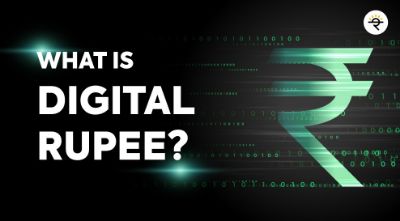What is Digital Rupee?
A month after testing the wholesale central bank digital currency, the Reserve Bank of India (RBI) on Tuesday announced a trial for retail digital rupee (e₹-R) commencing on December 1 with four banks in as many cities participating in the pilot programme.
What is Digital Rupee?
CBDC is a legal tender that is issued in digital form by the central bank, as stated by the Reserve Bank. It is interchangeable 1:1 with the fiat currency and functions just like a sovereign currency.
The central bank defined its goals for the digital rupee in a "concept note" on Central Bank Digital Currency (CBDC). It also outlined the justification for creating a CBDC and how it will function as an alternative.
Classification of Digital rupee
Central bank Digital currency can be classified into two types:
1) Retail (CBDC-R): Retail CBDC would be potentially available for use by all.
2) Wholesale (CBDC-W): is designed for restricted access to select financial institutions.
For the wholesale pilot project for the digital rupee which has rolled out on 1st November 2022, the RBI has chosen nine banks to take part. These include the Union Bank of India, State Bank of India, Bank of Baroda, HDFC Bank, ICICI Bank, Kotak Mahindra Bank, Yes Bank, IDFC First Bank, and HSBC.
The application of the wholesale digital rupee is for the settlement of transactions in government securities.
The Retail pilot project is going to get started on a trial basis from 1st December 2022. The program would cover selected locations in a closed user group (CUG) comprising participating customers and merchants and has identified eight banks for gradual participation. The first phase will begin with four banks including State Bank of India, ICICI bank, yes bank, and IDFC first bank, and would initially cover Mumbai, New Delhi, Bengaluru, and Bhubaneshwar.
How will the Digital rupee work?
The Digital rupee will be in the form of a digital token that represents legal tender. It would be issued in the same denominations that paper currency and coins are currently issued. Users can transact with E-rupee through a digital wallet offered by participating banks and stored on mobile phones. Digital rupee transactions can be both person-to-person and person to merchant. Payments to merchants could be made using QR codes displayed at merchant’s locations.
The advantage of Digital currency over existing digital payment systems is that payments through digital currency would be final, without requiring interbank settlement. Reducing operational costs associated with physical cash management, promoting financial inclusion, bringing resilience, efficiency, and innovation to the payments system, enhancing efficiency in the settlement system, and fostering innovation in cross-border payments are among the main drivers for considering the issuance of CBDC in India.
Future of Digital currency?
One of the main advantages for users is that the central bank's digital money would provide better anonymity than traditional digital transactions. India is a developing country with a number of digital payment options now, but this would give people even more choices. Currently, it is being done as a pilot, but once it reaches a certain critical mass, it will eventually become the next big thing in the payments arena. India is dedicated to building a digital payments ecosystem with innovations that realize the concept of "Ease of Living" and guarantee that social assistance benefits are provided to those who need it the most.



